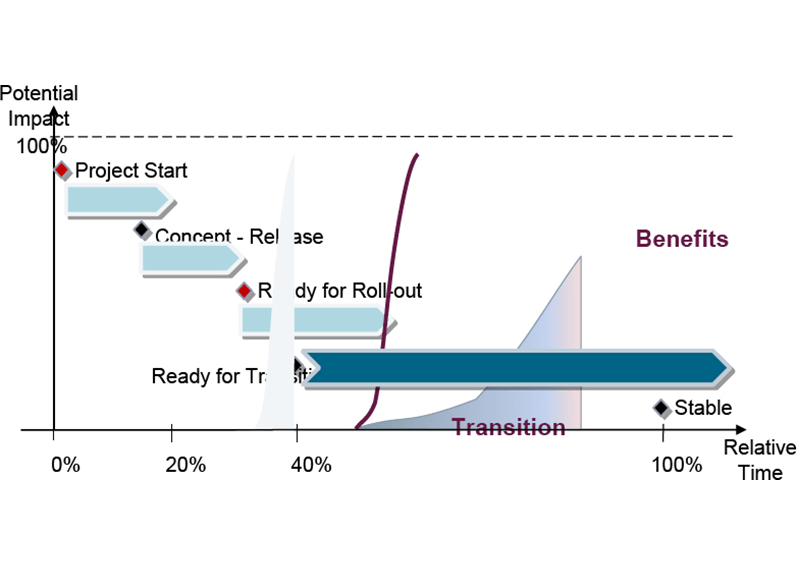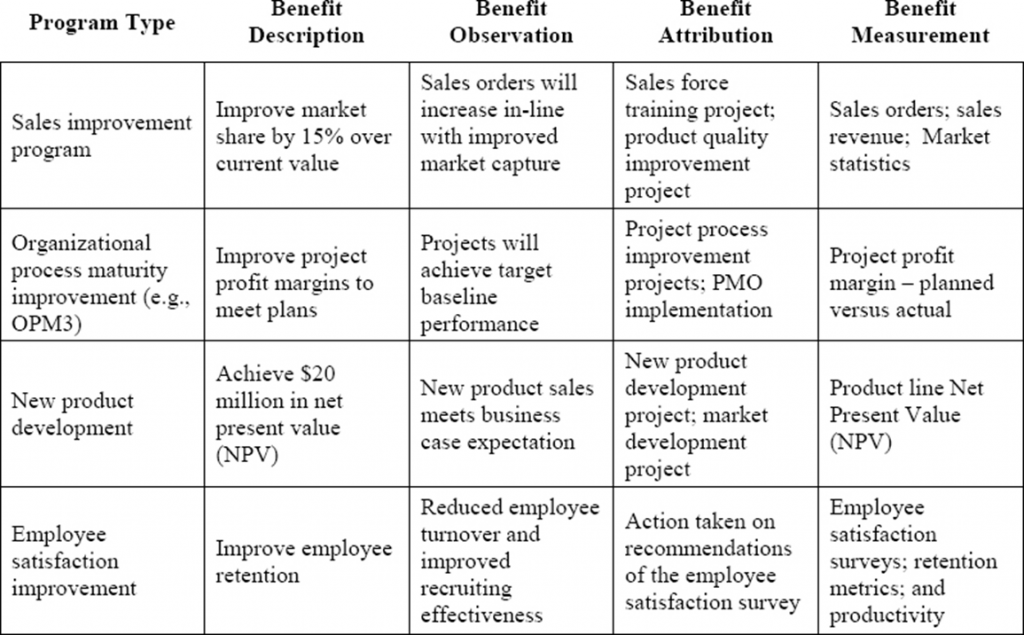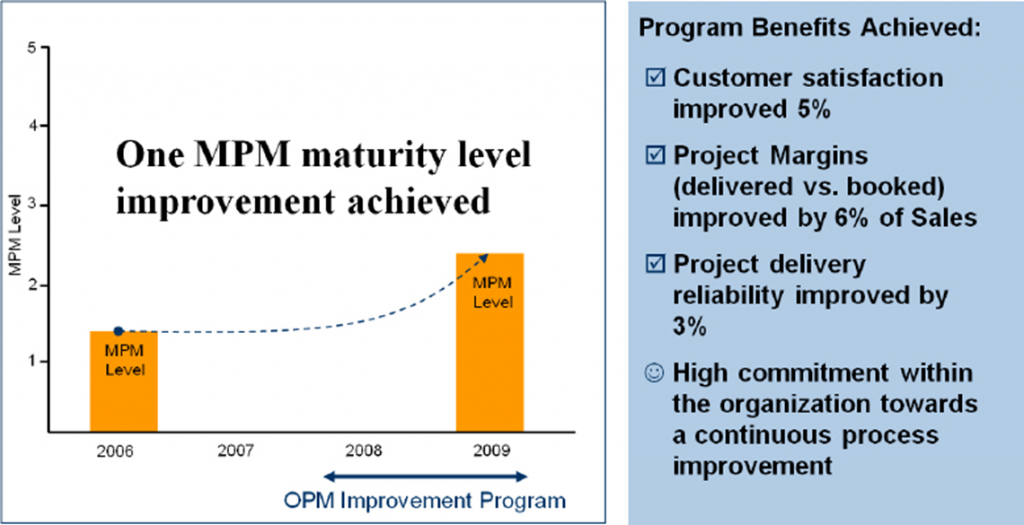‘Benefits management‘ and ‘benefits realisation management’ are terms that are becoming increasingly popular in the project management industry, amid efforts to sell large-scale corporate transformation programs and regulate their performance. However, after the sponsor has accepted the business case, these processes frequently come to a halt.
How is this possible in a highly competitive corporate environment when change is omnipresent, investments are micromanaged by financial controllers, and unsuccessful business transformation programs can jeopardize executives’ and managers’ careers?
The ability to adapt to change or the proper investment in new markets or products do not guarantee a company’s success. Instead, the overall benefit realized by adopting change through a transformation program is what determines success, and possibly even the existence of an organization.
What is benefit management?
The method of investing time and money in order to generate positive change in a project is known as benefits management. This is accomplished by identifying, planning, measuring, and tracking benefits from the start of the project until the completion of the project, when all benefits have been realized.
Identifying benefits
Benefits management should: Assessment of project scope management capability maturity using a checklist
- define the proposed work’s benefits and dis-benefits;
- develop systems for measurement;
- implement the necessary changes in order to realize benefits;
- measure the improvement and compare it to the business case.
|
Indicators |
Level 2 attributes |
Dis-benefits are considered to be covered as well, as is the case with all references to benefits. When determining whether a piece of work is a project or a programme, the complexity of the benefits management function is a deciding factor. Level 2 will suffice for projects with a clear link between a small number of outputs and a benefit. The identification of additional benefits throughout the life cycle at level 2 may not be complete. When numerous outputs and benefits have a many-to-many link, the task will most likely be executed as a program, and level 3 capability will be more appropriate. |
|
Quantify |
The benefits are measured and presented. The estimations of benefit amounts are backed up by evidence. |
|
|
Value |
Financial benefits are valued, and documentation explains why they are valued |
|
|
Plan benefits realization |
Benefits-realization plans are in place and are revised throughout the life cycle. |
|
|
Realise benefits |
There is some pre-change metric measuring, although it may be inconsistent. Individual business-as-usual units may be in charge of benefit reviews. |
|
Indicators |
Level 3 attributes |
|
Quantify |
For benefits, full benefit profiles are developed. Throughout the life cycle, they are reviewed. As new benefits are discovered during the life cycle, new benefit profiles are created. The updated benefit profiles and the business case are inextricably linked. Non-financial benefits are valued using sophisticated methodologies, with documentation demonstrating the logic behind the values. All benefits realization actions are either part of a distinct benefits realization plan or a portion of the primary project or program delivery plan. These plans are updated on a regular basis, and the interfaces are kept up to date. Metrics that are influenced by change are baselined prior to implementation and tracked during the implementation period. On completion, a full benefits evaluation is performed, and the actual net benefit is compared to the original business case. |
|
Value |
|
|
Plan benefits realization |
|
|
Realise benefits |
Why focus on benefits management?
In short, concentrating on benefits enables better program and project resource allocation decisions as well as faster organizational transformation. Advertisements stating that the best-in-class companies utilize a particular vendor’s products would like you to believe that the opposite is also true. Purchase our product and you will instantly become one of the most successful companies. If this were the case, completing projects on time would be enough to ensure business success. In fact, the “best” company is characterized by its ability to deliver a vision of a future state that is assessed by the realization of specified benefits. Simply having a new enterprise IT system or a newly developed product does not guarantee the company’s standing as a best-in-class organization. Furthermore, while projects are generally evaluated on how efficiently they produce a result (e.g., cost/schedule performance indices), programs are frequently viewed as long-term investments that expect a leveraged return on investment. This necessitates not just the delivery of new capabilities, but also the facilitation of organizational transformation and the realization of expected benefits.
Leadership, as well as the individuals who must change, must be committed to organizational transformation. People are more willing to change if they believe there will be a benefit to them, their business, or the consumer. When benefits are identified and program components are aligned to them, the program becomes a stream of projects and processes that bring value to the company. This makes it simple for the program to use value optimization methods like lean.
Benefits vs capabilities
One of the reasons why programs’ benefits aren’t always realized is a lack of clarity in defining and measuring them. For many project organizations, the change from evaluating project outputs (e.g., capabilities) to defining and measuring benefit accomplishment is a paradigm shift. Capabilities are the program’s enablers, not the program’s benefits.
“A benefit is a result of activities or behaviors that provide utility, value, or a positive change to the intended recipient,” according to The Standard for Program Management. A benefit is also defined as “the measurable improvement coming from an outcome seen as an advantage by one or more stakeholders, which contributes to one or more organizational objective(s)” by Managing Successful Programs. A benefit, according to Siemens, is a set of measurable improvements that give one or more stakeholders a business advantage. Benefits are typically linked and stakeholder-specific, and they can be both tangible and intangible. The following are some examples:
- Increase of market share
- Shorter time to market
- Higher employee retention
Benefits frequently include terms like “better,” “cheaper,” “faster,” or “bigger,” and they represent the program’s strategic objective being realized. It is critical to have a program vision. A program vision, according to Managing Successful Programs (MSP), should be a “postcard from the future” that describes the organization’s future condition after the program goals have been achieved. A program vision may be to increase market share to 35% of the available market while maintaining profitability. Improved market share and project profit margin might readily be defined as benefits that could be quantifiably measured to demonstrate program vision achievement in this situation.
The benefits, on the other hand, may not be as obvious if a methodology like MSP is not utilized. Take, for example, the improvement of organizational project management maturity as one of the program’s expected outcomes. The next discussion reflects a root cause analysis method based on the “five whys.”
When asked to explain the benefit of the OPM improvement program, the program manager often responds with something along the lines of “We will attain Maturity Level 3.” Maturity Level 3 is a measurement of the organization’s OPM capability maturity, not a benefit. The only benefit of reaching Maturity Level 3 may be the program manager’s or company senior leadership’s incentive bonus, but not more. Why does the organization desire to be rated at Maturity Level 3 in the first place? Then comes a series of questions:
Q: What are the benefits of reaching Level 3?
A: Our processes will be standardized.
Q: What are the benefits of standard processes?
A: All projects will follow A Guide to the Project Management Body of Knowledge
Q: What are the benefits of adopting the PMBOK® Guide for all projects?
A: We will deliver on time and on budget more frequently, increasing project predictability.
Q: Why is this significant?
A: We’ll increase customer satisfaction while increasing project profit margins.
We now have the true benefits! Improved customer satisfaction ratings and project profit margins indicate the program organization’s goal of increasing market share and profit margins. This analogy may be used for new product development, strategic account management, and other programs with ease.
Employee satisfaction or brand recognition are examples of benefits that are difficult to measure and are frequently referred to as intangible. However, it is not a benefit if you are unable to see or measure it. There are indications that may be seen to confirm the benefit achievement if you consult enough experts, even if it’s as basic as fewer employee complaints or enhanced recruiting or retention metrics. Companies spend enormous sums of money to put their names on racing cars or to organize worldwide sporting events for a purpose. These “soft” benefits are generally measured through surveys and polls, but the final result is frequently represented on the executive’s dashboard in terms of increased market share, more effective public service, or other organizational performance metric.
The concept of dis-benefits is another phrase introduced in MSP. These are measurable consequences of an outcome that has a negative impact on the organization’s goals. Employee morale impacts as a result of organizational reorganization or the impact on existing product sales on shop shelves when a new, enhanced product is released early are examples of dis-benefits. The program’s value is determined by the balance of benefits and drawbacks. We have the complete program business case when the net benefits are compared to the program costs.
Benefits drive organizational transformation
Benefits realization drives organizational transformation and changes the behavior of component project teams in a favorable way. Which would appeal more to the program’s component project teams: achieving Maturity Level 3 or increasing market share, project profitability, and employee satisfaction? Furthermore, the processes are carried out by humans. The new processes will not be properly transitioned and applied if they are not motivated (Image 1). People want to feel like they’re contributing to something bigger than just developing processes and filling out forms. Because of this emphasis, the component project teams can now perceive their work on the improvement program through the lens of organizational value optimization. The focus is on optimizing program value when project changes or decisions are necessary due to environmental factors. When the budget is cut, resources are reduced, or the market is down, the employees come up with new methods to deliver value.

In a case from 2001, a project team in the telecommunications semiconductor industry was constantly losing resources owing to problems in other projects inside the company. This became somewhat of a routine. To save the project, the program manager explained to the project team the importance of on-time delivery and the implications for the company. The team’s behavior changed when they realized that each week of delay cost over $125,000 to the program’s business case. Furthermore, owing to greater market capture, if two weeks could be obtained, the value each week would be above $250,000. The next week, resources were once again removed from the project for three days. “That’s $80,000!” exclaimed one team member. What can we do to avoid a $80,000 financial hit?” The team now had a strong financial case for project recovery that was on everyone’s mind. As a consequence, the program’s net present value was doubled and the schedule was recovered for 41 days (NPV). There were no financial incentives for the team; instead, they were rewarded with the joy of contributing to the organization’s success.
Defining benefits using benefit profiles
A benefit is not realizable if it cannot be specified or measured in any way. Description, observable results, attribution, and measurement are all included in a benefit profile. Image 2 shows examples of benefit profiles for several programs.
When a program vision is available and communicated, it is easier to describe a benefit. Many programs, on the other hand, are emergent in nature, which means that the collection of projects and related activity is already well along when someone recognizes it is a program. A vision should always be developed and the benefits of that vision defined, whether a program is vision guided or emergent. This will be crucial in validating and optimizing the work of program components. Even in cases when non-compliance may result in a loss of market participation (e.g., regulatory obligations), additional advantages to the organization should be considered.
Observable outcomes are discernible distinctions between the existing and future states of an organization (post-transition). In many situations, this is directly linked to the benefit’s measurement. Observable results, on the other hand, may be important in determining program success, as is the case with intangible measures.
The advantage is attributed to the program effort that is accountable and responsible for its creation. This is especially essential for evaluating the efficacy of program components. A benefits map, as detailed next, is a powerful tool for graphically displaying project component outputs and capabilities in relation to benefits of project management.
Benefits may be measured in a variety of ways, from simple financial measures to forecasting air superiority for a new jet fighter aircraft. The objective is to agree on reliable measurements that can be linked to the identified benefit. Benefits are also important aspects of program success, and they should be baselined at the start of the program (or at the very least before the start of the transition) to accurately measure trends and differences between the new and old states. Many programs struggle to demonstrate benefit realization because they never identified or established a capability to measure the benefit since it was simply expected to occur as a result of capability delivery.

It’s also crucial to communicate the program’s benefits and the link to component project performance. Project teams are frequently incentivized based on traditional triple constraints of cost, time, and scope, rather than the value they add to the program. Be careful what you incentivise – you could receive it! If a project team is motivated by cost, they will optimize their project to meet that goal, even if it means foregoing opportunities to increase program value. Every project is an investment in someone’s program. Often, that project is on the verge of providing program benefits. It is true that time is money. The business case for project optimization is the value lost or gained by the program as a result of time lost or gained. Devaux (1999) identifies two excellent project value optimization metrics: DRAG, which is the amount of time a critical path activity can be reduced without affecting the finish date, and DIPP, which stands for the project’s contribution to the program’s estimated monetary value (EMV) divided by the expected time to completion (ETC). The DIPP can be baselined at the start of the project and tracked throughout the duration. The projected benefits to cost ratio is larger than the plan as long as the DIPP ratio is greater than the baseline (e.g., enhancing value or decreasing ETC). Projects in the critical path have a direct impact on the program’s projected value and benefit delivery in terms of completion time.
Benefits management and business innovation
Change is something that programs are always dealing with. As the rate of change and development in businesses accelerates, innovation has been considered as a vital success factor for staying ahead in modern business. The higher the level of innovation, the greater the amount of organizational change. Programs are becoming more stable or longer lasting than traditional line organizations as a result of this acceleration in developing and implementing innovative ways of doing business. It is actually more probable for a program to have the original organization that promoted its vision change dramatically throughout the course of the program’s lifecycle than for it to remain the same. Changes in sponsorship and program vision must, of course, be carefully managed and reflected in the targeted benefits of the program (or even the beneficiaries).
Changes in the other program’s framework, such as market development, economic climate, or technology progress, not only provide new possibilities to provide the targeted benefits more effectively, but they also provide new opportunities to pursue other, unforeseen benefits. We at Siemens deal with the rising turbulence by regularly evaluating and revising our program visions and benefit maps to ensure that all stakeholders are still aligned with what the programs will achieve.
Case study example
In Siemens’ organizational project management (OPM) improvement program, image 3 illustrates an example of benefits alignment with capability development. The maturity in project management (MPM) model, which is detailed in Sopko and Strausser (2010) and Sopko, Yellayi, and Clark (2010), is the internal Siemens model for OPM capability maturity evaluation (2012). The program was designed to achieve three main organizational goals (benefits): Customer satisfaction, project profit margins, and project delivery reliability are all things that may be improved.

Benefits realization through effective program management is gaining attention as the global marketplace places a larger focus on the value arising from project investments. Projects result in outputs that serve as enablers. Program management is the means through which an organization’s transformation and benefits are accomplished and maintained. Benefits must be defined, measured, and actively managed for a program to produce value.
A focus on benefits is a vital facilitator for value optimization methods and methodologies like lean or value analysis/value engineering, as well as influencing the team’s attitude toward innovation and program value optimization. To ensure continuous program success, processes for benefits management defined in global program standards such as PMI and the UK Cabinet Office should be created and executed.
Visit our websites to get more information and a free PMP Practice Test. To download, visit our website for your IOS or Android device.

What is Project Management Triangle?
In this article, we will provide you with Project Management Triangle, each of the project triangle's elements. Let's get started!
January 1, 2022

Benefits Management and Benefits Realisation Management
If you are wondering about 'benefits management' and 'benefits realisation management'. Visit our website to learn everything!
January 1, 2022

PMP Review with A Successful Story
Let’s read PMP Review which may help you a lot! Visit our website to get more information and free PMP Practice Test!
January 1, 2022
